What do you want from your content?
Pardon the italics. I’m not hissing at you like Professor Snape. I’m just curious, because the answer differs from person to person:
“I definitely want more shares from my content. More shares = more potential readers = more potential customers.”
“My number one goal in content is to get more engagement. More views, more comments, the whole thing.”
“Forget about shares and all that. I just want a bigger email list.”
Any of those sound like you? They’re the most common answers to that question. But there’s one flaw with these answers…
They all focus on the outcome.
And focusing on the outcome – or what you hope to achieve with your content – is silly. That’s like being a baseball player, stepping up to the plate saying “Time to get a hit.”
You can’t control that outcome (especially if you’re a Minnesota Twins player).

I see this happen 162 games a year.
What you can control is your approach, your swing, the pitch you choose to hit, etc.
Those are elements of the process, and they’re within your control. Mastering the process leads to a hit. You can’t master an outcome.
Content is the same. Saying you want more customers, traffic, and shares won’t get you more of those things. You don’t control the outcome.
You control the process.
The process is how you build your content. The elements you include. The tone you inflect. And when it comes to process, there are three cornerstones that make your content great.
In fact, Sarah, myself and anyone that writes for Sumo don’t hit “Publish” until our content satisfies each of the three cornerstones. When we hit these cornerstones, any outcome we aim for takes care of itself.
And it can for you, too.
Tip: We also don’t hit publish until we’ve gone through every point in this checklist.
The Three Cornerstones of Outstanding Content
Forget all the articles that talk about what makes great content. Most times those guides are on sites that don’t publish memorable content themselves:

The stuff gets over complicated or too vague. Memorable content doesn’t need to have a massive checklist of 27 things you need to follow.
It comes down to three things:
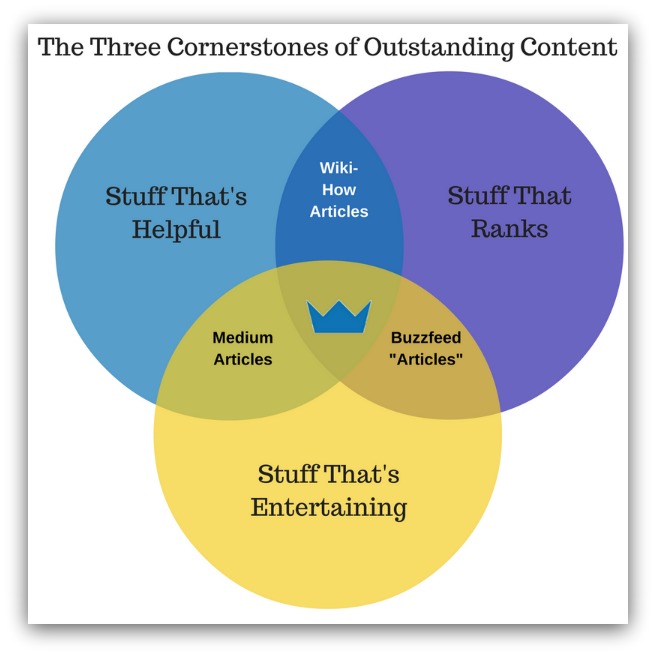
The three cornerstones break down like this:
-
Stuff That’s Helpful: Your content helps the reader accomplish something.
-
Stuff That’s Entertaining: Your content is engaging and holds interest.
-
Stuff That Ranks: Your content appears on search engines.
Alone, these cornerstones will make your content okay. If your content contains even one of these cornerstones, you’re ahead of many content creators. Because most people create content that’s not fun to read, doesn’t help anybody and is nowhere to be found on the internet? Yikes.
Combine two of these cornerstones and you’ll still create solid content. A lot of sites thrive from nailing even two of these cornerstones (like ESPN, Buzzfeed, WikiHow, Medium, etc.).
But if you nail all three of these cornerstones? Check it:
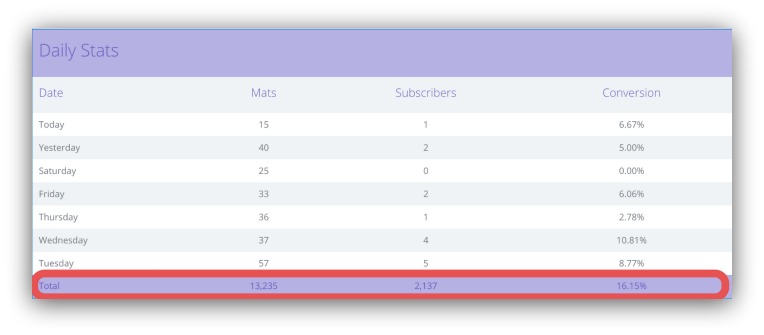
That’s one of our guides with 13k visits, 2,137 emails collected and steady organic traffic a month after publishing.
But doing this is easier said than done. That’s why I want to show you real-life examples of each of these cornerstones in action (and what happens when you combine them).
Spoiler alert. It’s this:

Voltron is what happens.
Let’s break it down.
Are You Not Entertained: The Entertaining Cornerstone
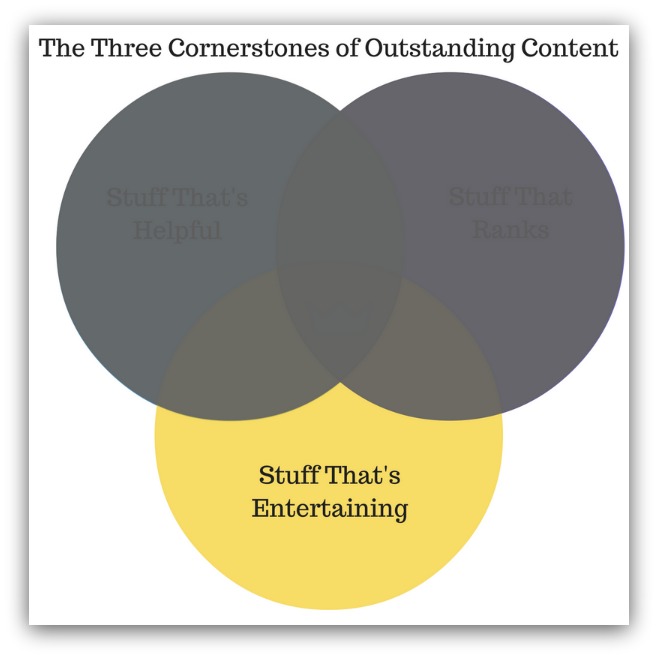
Did you know 42.5 billion hours of Netflix were watched last year?
If I had to guess, half of it came from House of Cards and Friends. Still, that’s a lot of time spent on entertainment.
It makes sense. We need to be entertained. After all, psychologists say the function of media entertainment is "the attainment of gratification." And so much of our lives are built around gratification — it’s the backbone of forming habits.
And here’s the harsh reality. You may have shrugged off the Netflix stat. “I’m not in the business of making moving pictures,” you might have said.
But you’re certainly competing against Netflix, whether you want to or not.
Time is a commodity. And content is content, no matter what form it’s delivered. We only have a limited amount of time in the day to consume the content we enjoy.
So if someone is staring down the choice between a bland article on the importance of Pinterest OR that new season of Stranger Things…

You see my point. Content that isn’t entertaining will be passed up for something that is.
What Makes Content Entertaining?
If I could give you the exact formula behind entertaining content, I wouldn’t be an internet marketing writer. I’d be making millions, putting an end to those terrible new Adam Sandler movies.
There’s not an XYZ combo that makes something engaging. Instead, there are elements (remember, it’s the process you control) that can steer you in the right direction.
1) Know Your Audience
A piece of content making references to Justin Bieber? Might work with the 15-30 demographic. The 40-60 group? Not so much.
Know who you’re talking to when you want to be entertaining. References, slang and even your topic need to reflect your target audience.
The easiest way to see what your audience wants? Spy on Twitter. Do an informal audit, seeing what your audience shares the most. Chances are that’s what they find most entertaining.
2) Keep Up With Pop Culture
Stephen King said it best:
“If you want to be a writer, you must do two things above all others: read a lot and write a lot.”
Makes sense. If you want to get good at something, you have to learn from others then try it yourself.
Same goes for entertainment. If you want to be entertaining, you have to follow entertaining stuff.
Want to be a Snapchat master? Watch the Snapchats from the most popular personalities in your area.
Want to connect with your audience? Watch what they watch. Read what they read. That’s why I can say I’m “working” when I watch Stranger Things. I’m keeping up so I can connect on things that matter to you.
3) Be Casual
This seems easier said than done. In video, your natural personality comes out. In writing, it’s a bit trickier.
The goal is to write like you speak. It injects your personality into the content. Because there are three kinds of people:
-
Those who can speak like a soothsayer, but write like a donkey.
-
Those who can write like Hemingway, but speak like Donald Trump.
-
….and the rare people that can do both well (don’t gloat).
If you’re in that first group, it’s frustrating to see your words look differently on the page than what you intended.
Here’s the easiest way to fix that. Go into Google Docs, click the “Tools” tab and select “Voice Typing.”

Then you can talk your way into writing content. Of all the methods I’ve tried, this is the best and easiest option for “writing” content.
There’s an easy way to see how entertaining your content is, too. For video, average watch time is a great indicator. It shows exactly how interesting your content is.
For writing, you look for how far down the page readers scroll. That shows how engaging your writing is. You can use something like Content Analytics to see that stat.
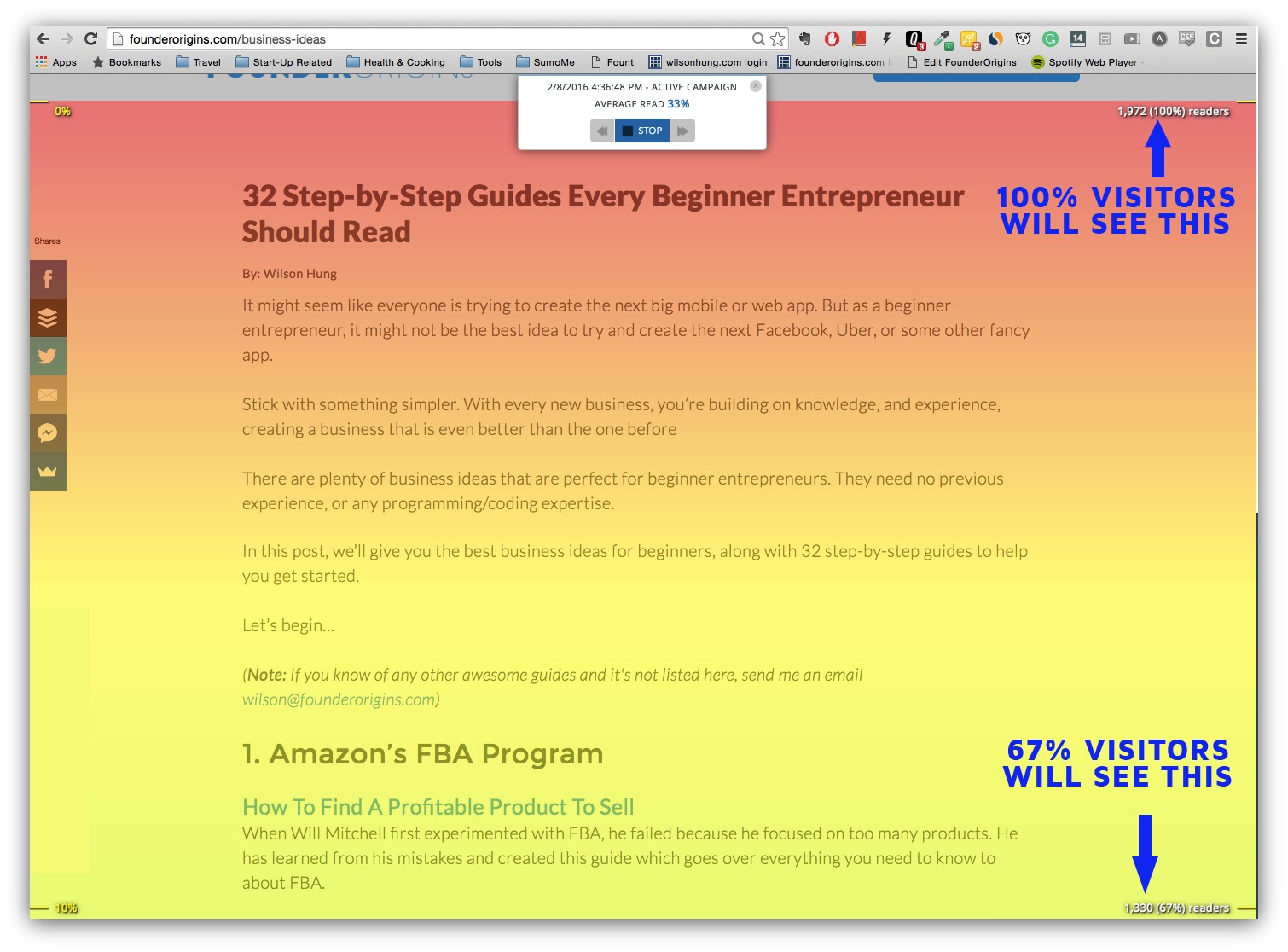
Over time, if you follow those three bits of advice, you’ll see your engagement levels go up.
Positives and Negatives of Entertaining Content
Entertaining content that isn’t helpful and doesn’t rank can be useful. But there are definitely some negatives to weigh against the positives.
Positives
-
-
Better chance of repeat visitors: Take Cracked for example. The articles are hilarious, but they don’t accomplish a whole lot. However, they’ve built a decade-long track record of putting out consistently entertaining content, so people check the site regularly.
-
Great for sites relying on ad revenue: If your site relies solely on visits to generate revenue, entertaining content is an absolute staple for your site. The constant flux of visitors after every new piece of content will drive your ad revenue up.
-
Powerful emotional response: Entertaining content gets shared. It appeals to our emotional brain as opposed to the logical one. Since emotion drives a lot of our decisions, entertaining content will inherently drive people to share.
-
Negatives
-
-
May not be helpful, searchable: Entertainment for entertainment’s sake won’t have the same impact for your business as something that’s entertaining, helpful AND searchable. Combining the cornerstones gets the most impact for your time.
-
Not sustainable for business growth: Since entertaining content alone is tough to create, it wouldn’t be wise to focus your entire B2B or B2C strategy on it. It only takes a couple misses to ruin your content strategy.
-
More misses than hits: Entertaining content is damn hard to create. Go look at Rotten Tomatoes — lots of flopped shows/movies there, and those people are professional entertainers. Banking on consistently entertaining content is tough to pull off.
-
Entertaining Example: Earthables
Believe it or not, you see this kind of content more often than you think.
Check your Facebook feed and you might see something like this:
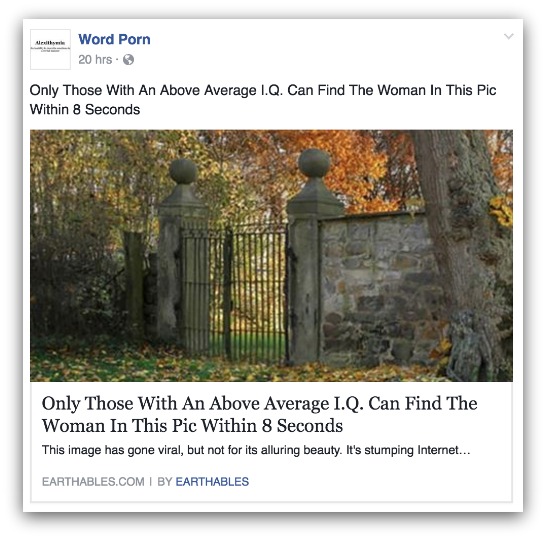
I’ll admit, I click on this stuff. It’s entertaining. Doesn’t a little part of you want to see if you can find the woman in eight seconds?
Word Porn and Earthables crank out this content constantly. It’s fun to read.
Is it helpful? Not really. I’m not going to let some image on the internet determine my I.Q.
Can you find it through search? Nope. This stuff doesn’t rank well with search engines.
So chalk it up as fun. They get ad revenue from posting on their social channels, but that’s about it.
But as a business owner, you need more than just entertainment. You need the sustainability of search for continuous traffic and the authority of helpfulness to prove you have the knowledge to help your visitors.
You Need Help: The Helpful Cornerstone
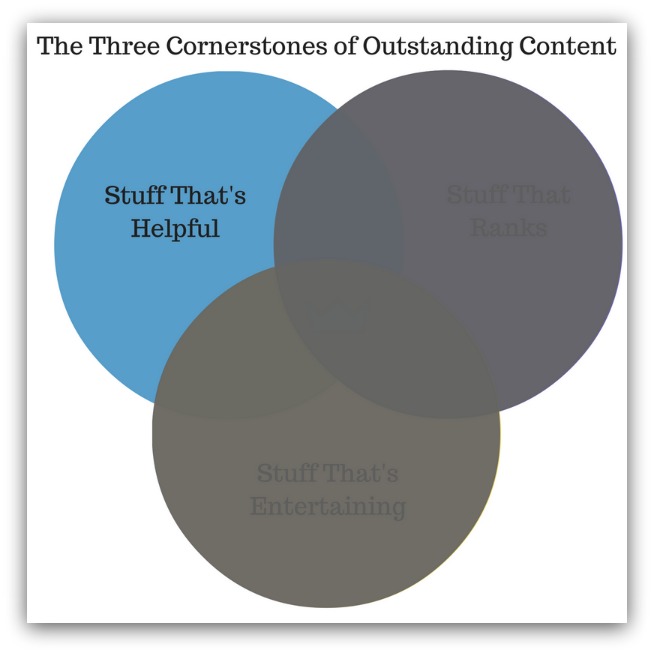
That might be my favorite line when it comes to creating helpful content. Though uh…
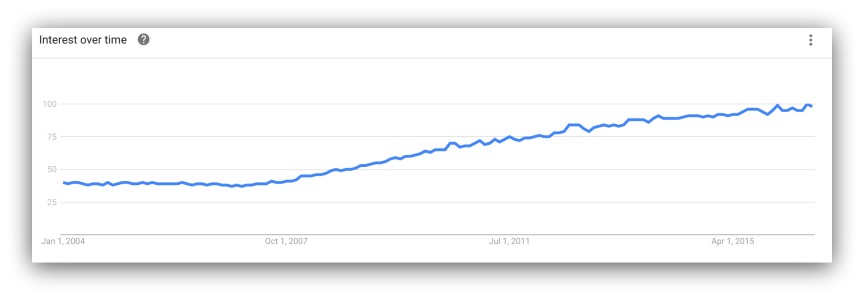
And it’s not just helpful content hidden behind a paywall anymore. We expect it to be free. Ramit Sethi preaches that point in almost every article and email:

So that’s what you’re competing against — world-class idealists, writers and business pros pumping out epic, helpful, free content.
That’s the kind of emphasis being placed on helpful content these days.
What Makes Content Helpful?
Honestly, it’s not rocket science. When someone gives you directions, you either get there or you make the wrong turn at a barn that doesn’t even exist.
If you want to get deeper, though, I like to abide by these three criteria:
1) Solve A Clear Need
My favorite method for generating content ideas comes from listening. I listen to the conversations support has with our customers. I listen to the questions I get from website reviews.
I even go to our WordPress plugin page and read the comments there.
After a while, you start to see a pattern of the same few questions asked. There’s a clear, real need for knowledge that’s already validated. When you can create content for that need, it’s an automatic win.
Go search through our stories. Every guide I write solves a clear need. Take this last guide I wrote about sending your first automated email. That came from doing website reviews and getting asked that very question.
The need is clear. All you have to do is listen and hit it.
2) Show Exactly How To Do Something
It’s one thing to write a 1,500 word guide on the “5 Interesting Things You Didn’t Know About Instagram.”
You might learn a thing or two. Maybe you’ll pick up THIS ONE WEIRD TRICK. But you’ll still more than likely have to draw your own conclusions because the content didn’t show you exactly how to do something.
Then there’s creating content like this. This guide on Instagram marketing shows you the exact steps to grow your Insta audience.
Everything is there. From the humble beginnings all the way to the deep finishing tactics that drove us over the top, you can take that guide and execute on the steps.
The specificity is what makes this guide so helpful. There’s no guesswork — you just do it.
3) Be Replicable
Some might think showing how to do something and being replicable are the same thing.
Michael Phelps could tell you his exact swimming style and technique. Think you’ll be able to swim like him?

The answer is no.
Showing how to do something isn’t enough. I know the feeling when you read something and think, “Yeah, but you did that because you had connections/money/access that I don’t have.”
It’s annoying. So the last step behind being helpful is creating content that is replicable.
This Sleep Sumo guide is a perfect example. We’ve shown time and time again on the blog how to grow your blog from 0 to X amount of visitors. And this time we took a random person and literally helped them grow their blog from scratch.
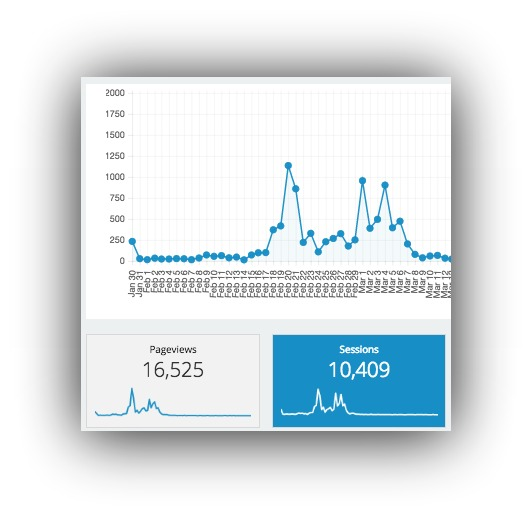
The advice isn’t just actionable. It’s replicable.
That’s what takes helpful content to the next level. If it solves a clear need, gives actionable steps and can be achieved, you know you’ve created something incredibly helpful.
Positives and Negatives of Helpful Content
Who’s the crazy person that would say negative things about helpful content?
Hi, Sean Bestor here. We know helpful content is great, but there are definitely some negatives of focusing solely on this cornerstone.
Positives
-
-
Strong brand builder: Whose site would you rather visit again? The person who made funny content that didn’t help you at all, or the person whose content helped you exponentially grow your business? Loaded question aside, being right and helping get people results will strengthen your brand like nothing else can.
-
Helping people achieve a goal: There’s nothing better than creating a piece of content and getting this kind of response: “For the last 24 hours I've been running it, my conversion rate is on FIRE. Getting triple the amount of daily email signups I was seeing before. This is insane.” Seeing real results from real people is great validation.
-
Negatives
-
-
Must actively seek out: These pieces of content won’t generally be easy to find…unless you know exactly what you’re looking for, so they won’t drive a lot of traffic to your site through organic search.
-
Aren’t enjoyable (usually): Solely helpful content isn’t there to make you smile. It’s there to help you accomplish something. This won’t be content that you’ll share on Facebook or go out of your way to recommend.
-
Helpful Example: Medical Journals
Medical journals might be the most personified example of this cornerstone.
Here’s a journal entry called “Impact of Non–Infarct-Related Artery Disease on Infarct Size and Outcomes.” I don’t know why I even linked it. With a title like that, you’re most likely not going to read it.

I am not a smart man
Either way, this article is incredibly helpful for doctors. It provides groundbreaking information, meticulously describes their methods and gives a repeatable process.
However, it’s a dry read and you have to dig deep in the internet to find it. You have to be the right kind of person to need this content.
Though, of the three content cornerstones, being helpful is the strongest option. If you can only be helpful, you’re farther ahead than anyone else.
The Search Is Over: The Ranking Cornerstone
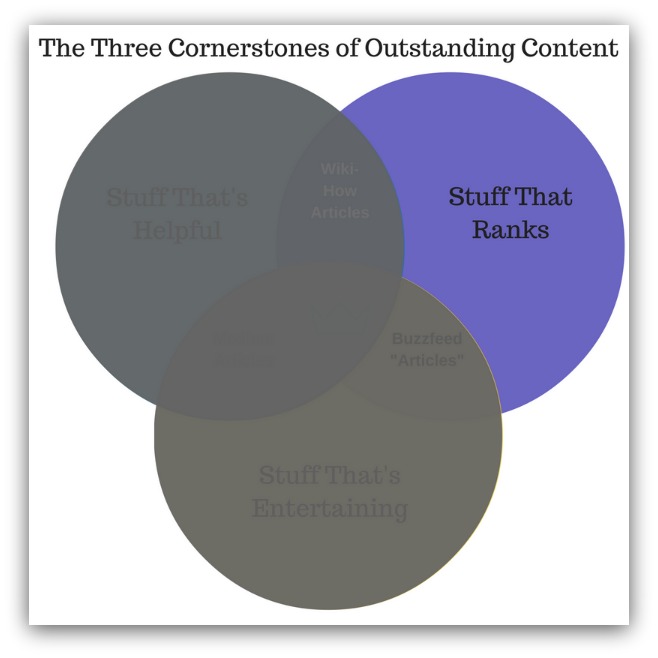
Do you know how crazy important it is to rank right now?

This is what site traffic looks like without SEO. The traffic is insane when you publish your content, and then it just nosedives.

But this is what your site traffic can look like when you crush SEO. You don’t have to spend money to get this traffic. You don’t even have to sit there and schedule an endless barrage of tweets to get this.
SEO works for free. It generates traffic while you sleep. That’s why Search Engine Watch is the 5th most popular marketing blog in existence.
Ranking on search is no joke. It can change yo’ life. But it’s a tedious process that requires some serious know-how.
But I’ve got you covered on that end.
What Makes Content Rank
Short answer? Many, many things.
A bit longer answer — there are some things you should, at the very least, pay attention to. Specifically:
SEO Tips Before You Create
-
Find Your Keyword: Focus on a keyword that A) Gets great, consistent traffic and B) Relates to your business/content.
-
Build A Sitemap: Your sitemap is like a roadmap for search engines — it helps them find your pages quicker (meaning easier to rank).
-
Make Sure Your Site Is Mobile Responsive: Google now penalizes non mobile-friendly sites. If your page is slow or hard to navigate, Google will drop you down the rankings.
-
Lower Your Average Page Load Time: Each second your page loads drops your conversion rate. The slower your site, the worse your ranking.
SEO Tips When You Create
-
Spend A Lot Of Time On Your Headline: Your headline is the first thing people see when they search. Spend extra time to make it insanely clickable and enticing.
-
Get Your H-Tags Squared Away: Your H-tags are like an inverted pyramid. Important keywords go in the highest H-tag (H1), and so on.
-
Balance Out Your Meta Description: Include your keyword in the meta description (what appears under your title in search).
-
Clean Up Your Slug: Make your URL clear and straightforward, with the keyword as close to the main domain as possible.
-
Nail The First 100 Words: Include your keyword in the first 100 words of your content to help signal that word to rank.
-
Give Your Proprietary Images Clean Meta: Put your keyword behind your images. You can usually put it in your alt-tag (easy to find in WordPress).
-
Link. Link. Link: Link throughout your content to relevant articles and your own articles.
-
Actually Make The Content Good: Self-explanatory. If it’s bad content, no one will visit. No traffic = bad rankings.
SEO Tips After You Create
-
See How Far Down The Page They're Getting: Use Content Analytics to see how far down the page people read. If it’s low, adjust the content to increase time on page.
-
Get Traffic: Traffic notifies search engines that your page is valuable. Valuable pages rank higher (usually). Drive traffic, drive up rankings.
-
Build Those Backlinks: Other content linking to your content is a HUGE indicator of valuable content.
-
Publish Consistently: The more consistent you are, the healthier your site looks. Unhealthy or dead sites don’t rank well.
-
Audit Every 3-6 Months: Always monitor how well you’re doing. Blindly publishing content won’t help you move the needle.
If you follow those tips, your content should rank well.
Positives and Negatives of Ranking Content
Let’s be real. The positives FAR outweigh the negatives of content that solely exists to rank. That’s because getting on the first page of a search engine takes a lot of time and things going right to happen.
But remember — there are things that rank well and that’s it. SEO is a game, and it can be manipulated through some not-so-reputable acts. That’s where the negatives come into play.
Positives
-
-
Free: So nothing is completely free, but SEO is an upfront matter. Putting in the time means you can kick back later and get free traffic to your site (no time or money on your part).
-
Guaranteed Search Traffic: If you’ve targeted a specific keyword, you know how many people search for that term in a given month. Where you rank determines what portion of traffic you’ll get. Suffice to say, organic content will get you constant traffic every day.
-
Negatives
-
-
Not Too Helpful: This content exists to rank well. When you read this content, rarely do you leave feeling satisfied. The information is just….there. You don’t learn from it. It just exists.
-
Dry to Read: Content that only ranks has beaten the system somehow. Because of that, they’ve usually sacrificed entertaining content for copy written specifically for robots (read: search engines). Very rarely do real people enjoy reading the content.
-
Beating the system is, thankfully, harder and harder to do these days. Yet still, some content slips through the cracks and ranks very well. And that content reaps the benefits of free, consistent traffic…for now (cue the ominous laugh from Google HQ).
Helpful Example: Nope
Here’s the deal. I’m not going to link, screenshot or directly mention examples of this content because I don’t want them to rank even higher.
But here are the characteristics of content that solely rank high:
-
Between 800-1400 words
-
Keyword is used a little too frequently — to the point of blatantly noticing without a tool what the keyword is
-
A large amount of backlinks that either don’t make sense (.orgs linking to it) or are manufactured
-
Lower interaction (comments and shares)
Again, you don’t see this kind of content often because Google has done a good job with penalizing bad content (plus the new Penguin rollout should help).
But when it does exist, you leave the content feeling a sense of “what did I just look at?” It drives traffic, but that traffic (you) does nothing on the page.
You know what’s really exciting, though?
The game-changing results you get when you start combining these cornerstones. Check it out…
How to Combine Cornerstones (And Make Great Content)
The three cornerstones of content are meant to be combined. On their own, they’re kinda meh (though they still work).
But with their powers combined, they’re like a marketing version of Captain Planet:
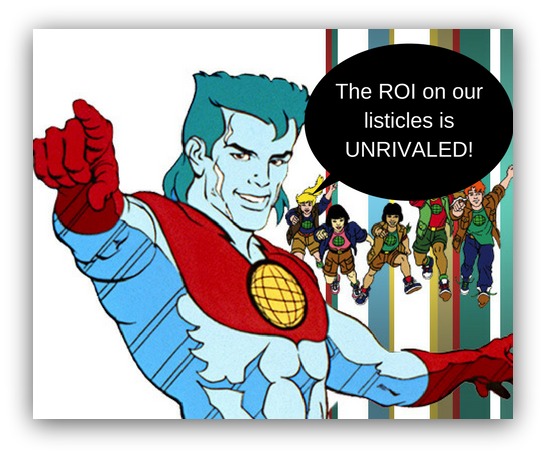
The Captain Marketing spinoff didn’t perform so well
I’ve shown you how to create content in each of the three cornerstones. That’s the easy(ish) part.
The hard part comes when you start combining those cornerstones. Weaving in the elements behind each cornerstone is hard, but the best content comes from that intertwining.
Here’s how you’ll know this content is flat-out better. You might not have recognized the examples I used for each cornerstone. But you’ll 100% know the examples I’ll use in these cornerstone combos.
Just be warned. The more cornerstones you add to a piece of content, the more time-consuming and difficult it is to correctly execute.
But if you want content that really matters, you’ll need to pay attention and put in the time so you can get it right the first time.
So let me walk you through the different combos of the cornerstones (and what that kind of content looks like).
Bill Nye Approves: The Entertaining and Helpful Cornerstones
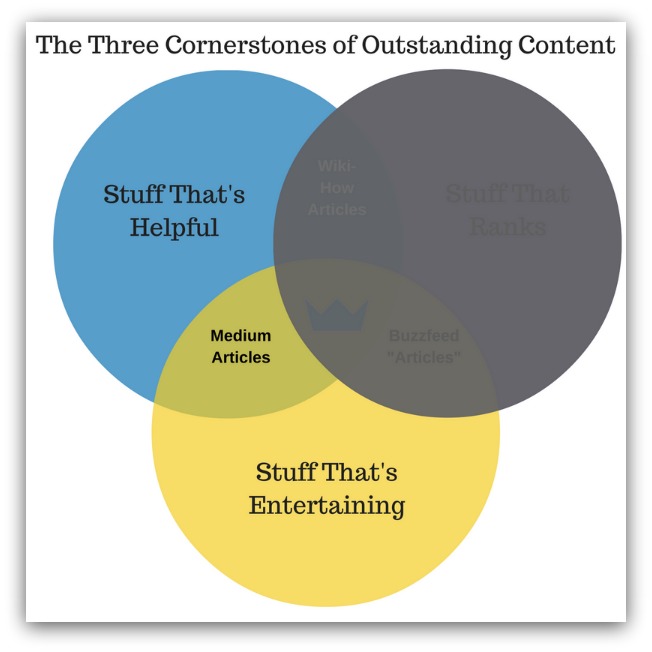
Commit this word to memory:
Infotainment
I love when people smash words together to create newer, cooler words like infotainment. And really, the meaning is in the word — it’s information that entertains.
We’ve all been there. It’s the difference between being in middle school watching a boring documentary or Bill Nye the Science Guy. One is informational, but the other is information in an entertaining package.
And if you swing more in the “give me facts not anecdotes” camp, check this out:
-
One groundbreaking study found that retention of humorous content was significantly higher than non-humorous material six weeks after exposure.
-
Another study examined The Daily Show and traditional news outlets. The study revealed people found The Daily Show far more credible than the news outlets.
Sign me (and you, I assume) up for informational content that can be more credible and memorable than regular informational content.
Positives and Negatives of Entertaining/Helpful Content
Admittedly, the negatives get tougher and tougher to pick out when you start combining content cornerstones. It’s more situational than anything, but the disadvantages are important to note when you get into this high-level content.
Positives
-
-
More Memorable: Retention is higher. The more memorable your content is, the less you have to rely on marketing it yourself. And if you’ve got an important message to spread, it’ll be that much more sticky if it’s entertaining.
-
Well-Received: The content is liked more than traditional informational content. It shines a new light on information, getting people to talk and share with their friends (love word of mouth marketing).
-
Negatives
-
-
Lacks Easy Staying Power: Because this content doesn’t rank, it’ll have to rely on word-of-mouth marketing, shares and bookmarks to drive consistent traffic. It won’t see the same day-over-day traffic as content that ranks.
-
It’s Situational: Not all content can be entertaining. Obviously some deep or very serious subjects can’t dip into completely entertaining or funny territory. While powerful, some subject matter will have to stray from this type of content.
-
Of the two-combo cornerstones, this is my absolute favorite. If you can be helpful and funny at the same time, you’ve created A+ content that people actually want. With a little work, it’s easy to turn this content into something that ranks, too.
Helpful/Entertaining Example: Medium
For those that don’t know, Medium is a massive community where anyone can post content on any subject. Think of it as a cooler, cleaner Tumblr.
The content that rises to the front page is real, legitimately good content. And most times, that content is helpful and entertaining:
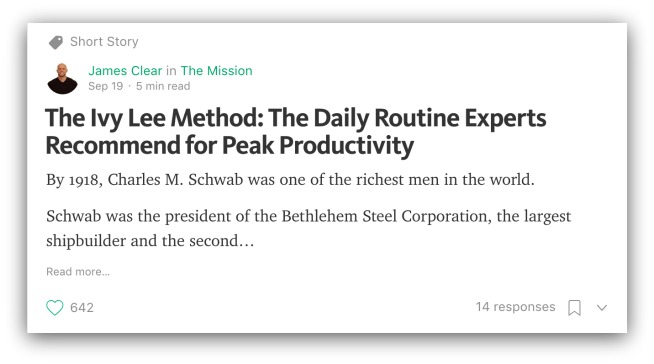
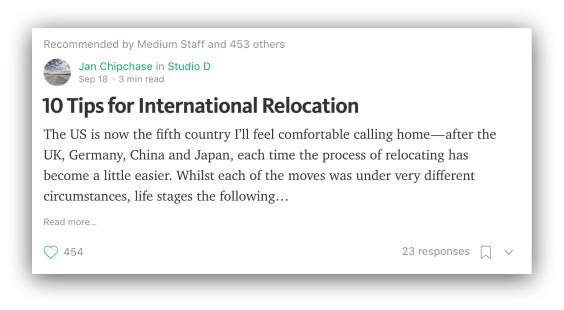
These are just a few examples I pulled randomly from the front page. They’re fun to read and give a lot of excellent, helpful tips.
But rarely will this content rank. Medium as a whole doesn’t rank in in search engines, but that’ll change soon. For now, this kind of content remains, as a whole, helpful and entertaining.
Harry Potter Quizes Forever: The Entertaining and Ranking Cornerstones
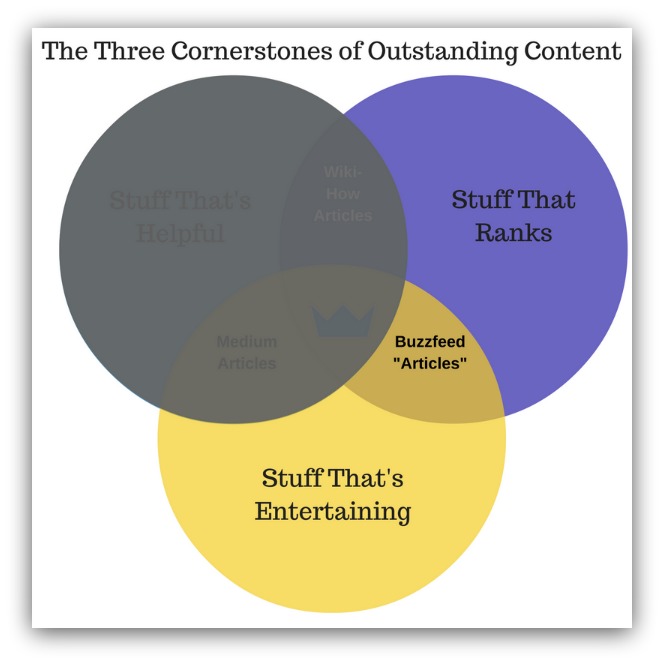
Now more than ever, we’re surrounded by a sea of entertaining content. Three things make that content rise to the top:
-
Content so relevant and amazing it goes viral
-
Creators so next-level that people naturally follow them (and their content)
-
Content fitting a need that ranks high on search engines
Those first two seem natural, but the last example might look out of place. And it may seem weird that purely entertaining content would rank well. But here’s the key:
The entertainment is inherent in the search.
That’s a heavy phrase, but here’s what I mean by it. If you search for “national debt crisis 2016” you know you’re going to get a litany of serious, helpful articles (news counts as helpful). You don’t expect to find super entertaining things on the subject.
However, if you searched “which harry potter character am I,” you’d expect to see some fun quizzes:

I’m Dumbledore, btw.
The two searches inherently ask for different types of content. The first is clearly looking for helpful content, while the other is of course going to turn up something entertaining.
That’s what I mean by the entertainment is inherent in the search. More often than not, the search will dictate if helpful or entertaining content will appear.
And if you’re sitting back wondering who the hell searches for stuff like “harry potter character quiz”….well….

A lot of people are.
So while we’re used to entertaining content coming to us in the form of Snapchat, Vine, Instagram and Facebook. But searching for entertainment still plays a prevalent role in search marketing.
Also…I wouldn’t be doing due diligence if I neglected fringe cases like this:

You get that when you search for “2016 presidential race.” This article isn’t helpful, and it’s there for pure entertainment purposes. But it ranks on a search term that isn’t primarily an entertaining topic.
Only big media outlets can make entertaining content that ranks for more serious search terms. If you try to do this, you’ll have a tough time competing with their traffic and shares.
Positives and Negatives of Entertaining/Ranking Content
Positives
-
-
Gateway to Other Content: Visitors come in for one piece of entertaining content, then stay to see more of your content. Visitors coming from search engines should increase your amount of pageviews per month.
-
Brings A Lot Of Traffic: Combining the power of natural word-of-mouth and share traffic from entertaining content with the consistent traffic of ranking content seems almost unfair. But when you create content like this, you tend to see large, sustained traffic.
-
Negatives
-
-
Can Be Overtaken Quickly: Entertaining content, rank or not, still falls victim to time. It only takes a day for a piece of content to go viral, which means it can overtake your content in the blink of an eye.
-
Flash In Pan Keyword: This is the curse of entertaining content that ranks. You could rank for a trend, but once that trend is gone your content is essentially dead.
-
So your content can generate massive traffic with this strategy, but it also falls victim to time and trends. Once the trend is gone, your content is done.
Entertaining/Ranking Example: Buzzfeed
Buzzfeed is the king of entertaining content:
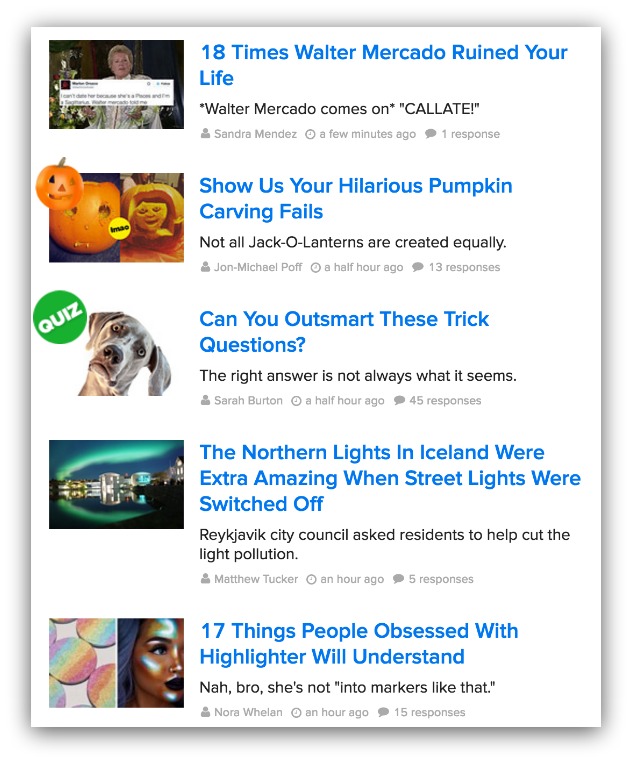
The front page of Buzzfeed today
None of these articles are helpful. But they’re super entertaining to a wide audience.
Plus, since the content is so entertaining, the traffic they get instantly helps their content rank. That’s why you see stuff like this:
%(18)
Buzzfeed cranks out so much entertaining content on a daily basis. Not every piece of content ranks, but that volume of content means they’ll at least rank for a few pieces every day.
And they’re so timely with content, it almost guarantees they’re a top result for any event or trend that suddenly surfaces. Their short format combined with entertaining volume makes them a clear leader in this content category.
Let’s Just Ask Jeeves: The Helpful and Ranking Cornerstones
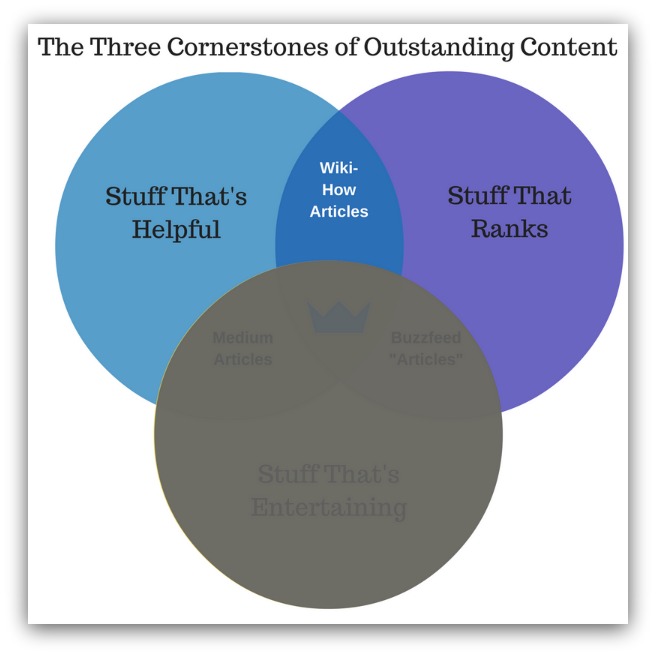
Imagine you’re back in 1999. Put on some Will Smith and say “crunk” a few times if you’re having trouble visualizing.
You go out to your car, but guess what? You’re greeted with a flat tire.
No problem, except you don’t know how to change a tire.
What would you do? Go inside and call someone to help? Nope, they’re all busy. Google it? Nice try — Google was just invented a year ago, and the content is severely lagging.
Enjoy shelling out your $120 for a tow and tire change.
Alright, come back with me to the awesome land of 2016. Tire is flat, so let’s just Google this on our phones/computers:
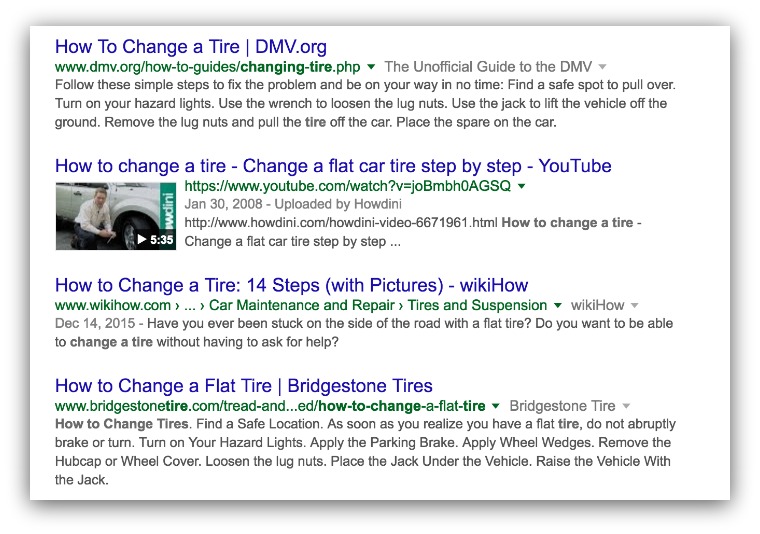
Articles, videos, step-by-steps with pictures….in the 21st century, you can do anything because helpful content is easily accessible through search engines.
You can literally search “how to ______” and you’ll get free content showing you exactly how to do that thing.

What a time to be alive…
The chief difference between solely helpful content and helpful content that ranks is demand. That scientific journal I referenced in the helpful cornerstone? No one is searching for it.
But changing a tire?

The people need to KNOW
Imagine being the top result for that term? We know the top spot gets at least 33% of clicks. If we assume 90k people search for tire help in a month, you get anywhere from 33-45k visits to your site every month.
From one piece of content. That’s insane!
For your business, it comes down to finding the intersection between what your subject matter is and what people need help with (Google Keyword Planner Tool helps with that).
Positives and Negatives of Helpful/Ranking Content
Positives
-
-
Can Rank Forever: If your content is the best solution for a problem, it can stay at the top of search engines for a very long time. That long-term domination means you get the bulk of search traffic. Niiiiiice.
-
Amazing Driver of Business: Visitors come to your site to get an answer. If your content is helpful, they’re more likely to visit you again. The more they visit you, the more likely they are to try your product.
-
Negatives
-
-
Hard to Outbound Promote: Most visitors need your content situationally. Event-based content (tax season, making food for holidays, etc.) are easier to do. But most helpful content is sought out on the visitor’s terms.
-
Bounce Rates Can Rise: Chances are visitors are on your site just to see your one helpful piece of content. If that’s the case, they’ll leave once they’re done. If you don’t have supplementary content or calls to action, you risk being a “one-and-done” solution.
-
This type of content can honestly be the cornerstone of your site, bringing in loads of traffic and high conversions. You only have to equip yourself to keep visitors on your site to make this type of content truly great.
Helpful/Ranking Example: WikiHow
Do you know how many websites exist today?
Do you know where WikiHow ranks in terms of traffic among those sites?
470.
That’s an extremely high rank. In context, this site is 12,292.
WikiHow is that popular because their content is geared to solve problems. The title of almost every piece of content starts with “How to.” Heck, this is their homepage:
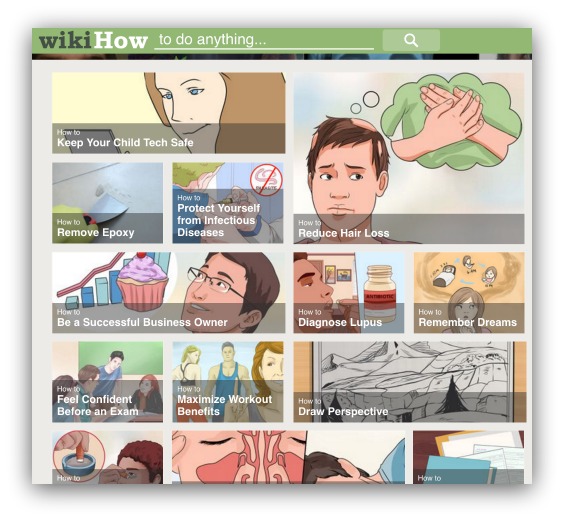
All 1,000,000+ articles answer a question in a helpful way. And when you search “How to ______,” WikiHow will be in the top few results:
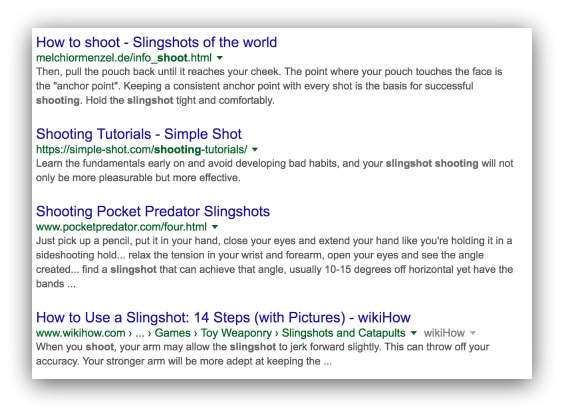
I have diverse interests
This is forever content. Helpful content that ranks can take your site from unknown to hundreds of thousands of visits a year.
The Holy Grail:The Entertaining, Helpful and Ranking Cornerstones
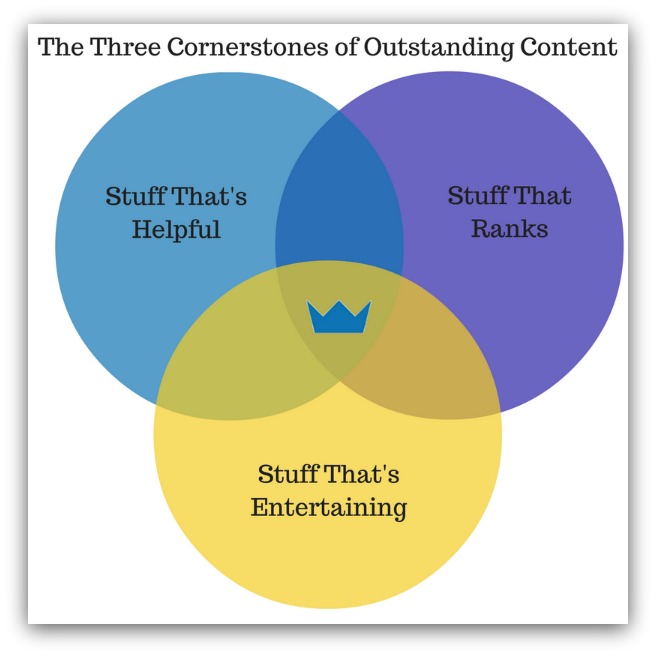
You feel that?
We’re in rare air.
We’re talking about content that hits every single cornerstone. No site does this consistently. Most times, when you’re creating “epic content” you aim for this. Sadly, most of these noble endeavours end by hitting two of the cornerstones (if you’re lucky).
There’s not much to cover here, because there aren’t many downsides of this content. If you can pull it off, you’ve created truly special content.
So instead of going through disadvantages that don’t exist and glossing over things you’ve already read, let me show you examples of this kind of content.
Helpful/Entertaining/Ranking Example #1: How To Get Free Facebook Traffic
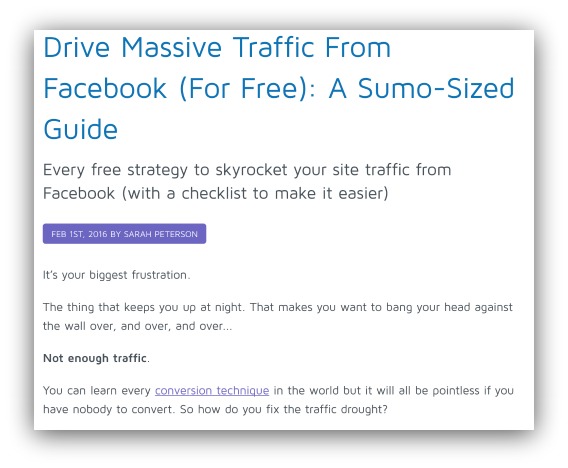
Our own Sarah Peterson wrote this firecracker of a guide. And good lord, there might not be a better example of three cornerstone content than this.
Is it helpful? Absolutely. It’s 8,000+ words of the exact steps you can take to get free traffic from Facebook. Everything is actionable, and everything is repeatable.
Is it entertaining? Hell yes it is! How many boring pieces of content use images like this:
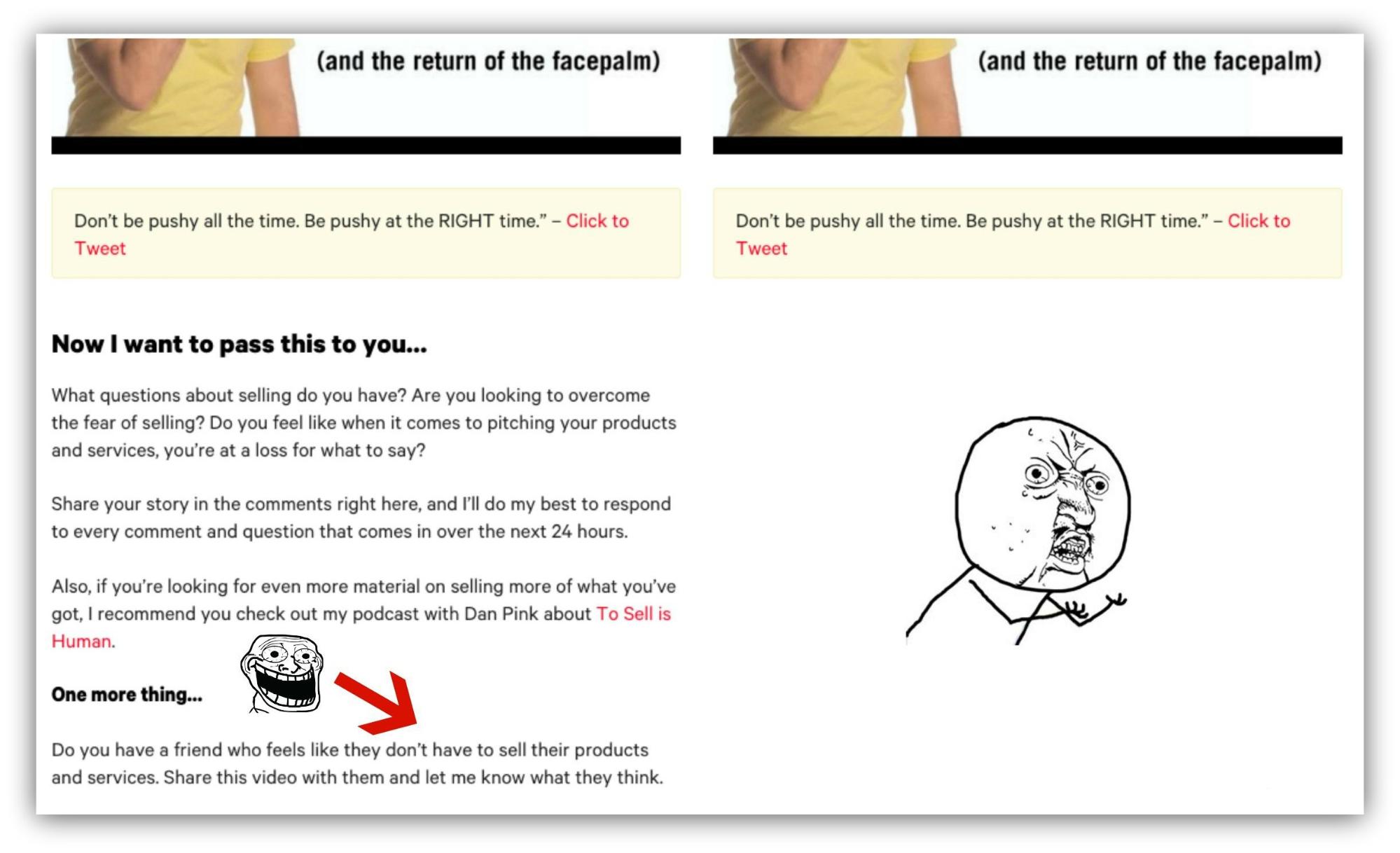
Zero is the answer. It’s ridiculously entertaining to read, and before you know it you’ll be through 8k words and wonder where the time went.
Does it rank? You know it:
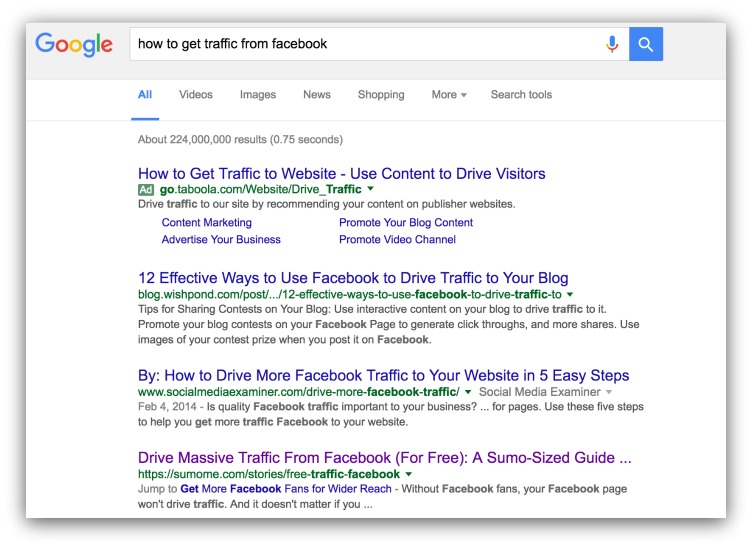
#3, baby. But don’t take our word for it. Check out the guide yourself to see.
Helpful/Entertaining/Ranking Example #2: Beginner’s Paleo Diet Guide

Fact: Nerd Fitness might be the most entertaining fitness blog on the internet.
Plus, they use Sumo, so bonus points, right?
They create top-notch content, but this guide on the Paleo diet was on a whole other level.
Is it helpful? Uh-huh. I knew nothing about the Paleo diet, and after reading that article I felt like a pro on the subject.
Was it entertaining? You know it! The words kept me scrolling, and it helps that it’s chunked up with images like this:
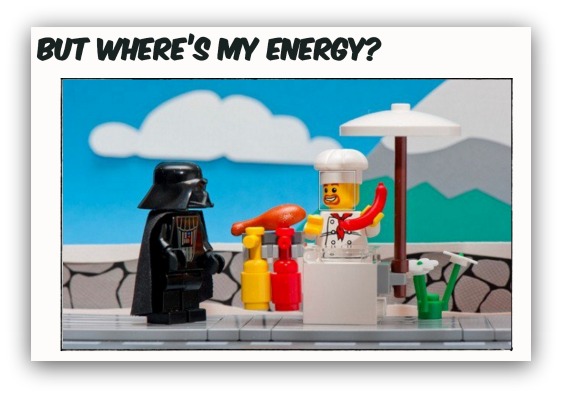
And does it rank? See for yourself:
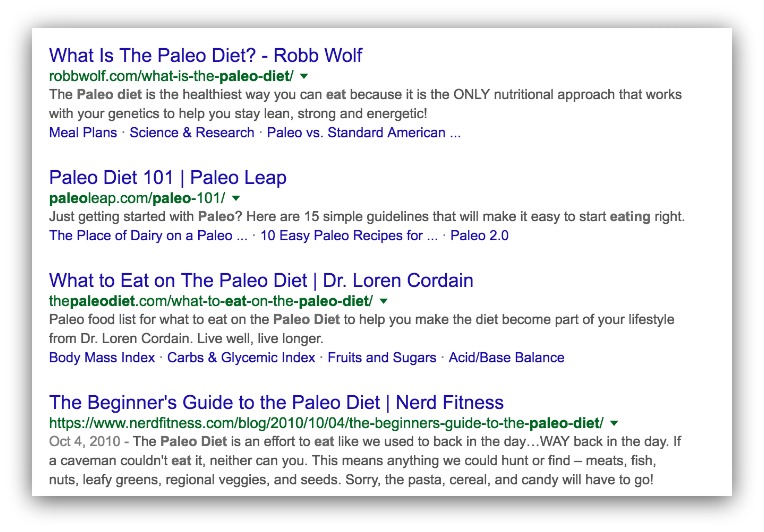
Great content from a great site. Make sure you check it out to see what I mean.
Helpful/Entertaining/Ranking Example #3: How To Write Subheads
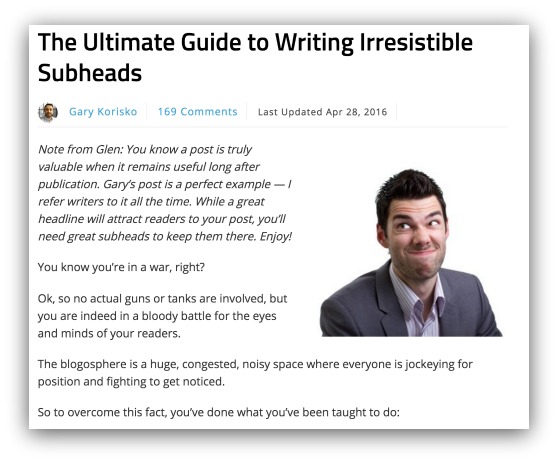
This one might be nerdy. But whatever, I’m writing this guide. I care about subheads (the section titles in an article) and this guide is one of the best on the subject.
The content is insanely fascinating. I was in the middle of a deadline for a guide and I still read the whole thing. Entertaining? Check.
Does it rank? #1, as a matter of fact:

And is it helpful? 169 comments on the article can’t be wrong. This is a definite three cornerstone piece of content, and you should check it out for yourself.
But You’re Still Not Ready To Publish…Unless You Use This
You may think you’ve created the most entertaining, helpful content that’ll sit at the top of Google for years to come.
But thought and reality are two drastically different things. Chances are, you’ll still feel that doubt before you hit “Publish.”
Do all my links work?
Will this make sense to my readers?
Will people even care?
Be honest. There’s always that little hesitancy, fueled by a voice in your head, that makes you hover over the publish button a little longer than normal.
That’s why I’m giving you something cool. I feel those same doubts, which is why for the past 10 years I’ve used the same spreadsheet over and over to quiet those doubts and publish epic content.
And I’m giving you that very same spreadsheet today. Click the link below to grab it and never worry about publishing again.
Add A Comment
VIEW THE COMMENTS